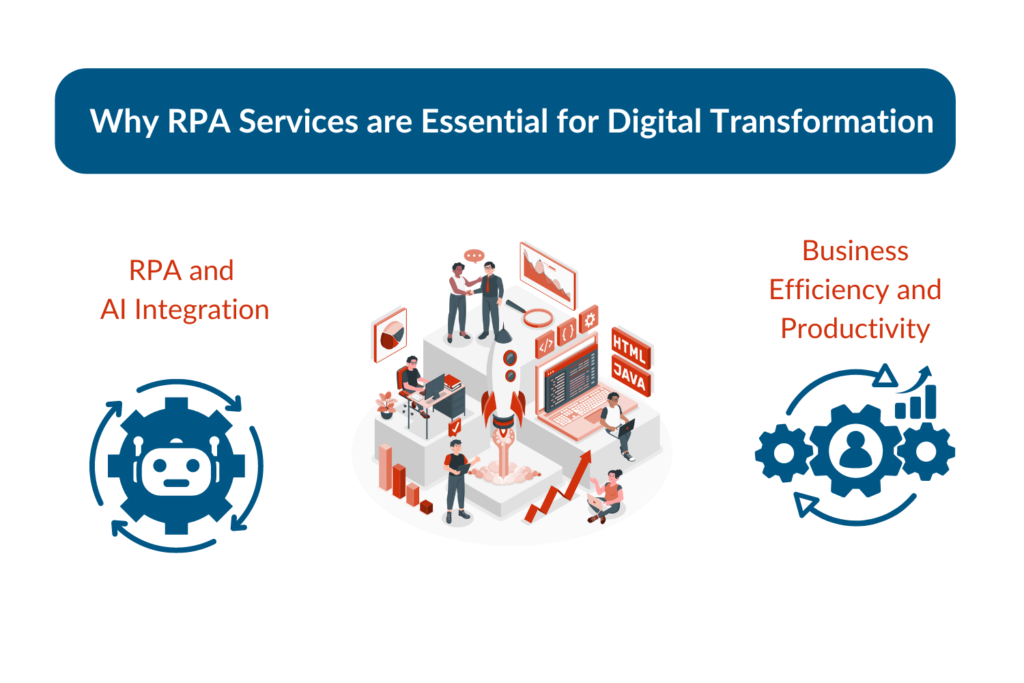In the digital age, businesses are constantly seeking ways to streamline operations, enhance efficiency, and drive productivity. One technology that has emerged as a game-changer in this regard is Robotic Process Automation (RPA). RPA services, when integrated with Artificial Intelligence (AI), can revolutionize business processes. They can automate repetitive tasks, freeing up human resources for more strategic roles.
But what exactly is RPA?
In simple terms, RPA is a technology that uses software robots or ‘bots’ to automate routine tasks. These tasks, which were previously performed by humans, can range from data entry to complex problem-solving.
The beauty of RPA lies in its ability to mimic human actions within digital systems. This allows it to interact with business applications just as a human would.
But RPA is not just about automation.
When combined with AI, it can handle unstructured data, make decisions based on predefined rules, and even learn from past actions. This synergy of RPA and AI is what makes it a powerful tool for digital transformation.
For tech businesses, the implications are profound.
RPA services can help businesses scale rapidly, reduce operational costs, and improve service delivery. They can also enhance data accuracy, ensure compliance, and lead to better customer experiences.
However, implementing RPA is not without its challenges.
Choosing the right RPA service provider, integrating it with existing IT infrastructure, and managing change are all critical aspects that need careful consideration.
In this article, we will delve deep into the world of RPA services. We will explore their role in digital transformation, their synergy with AI, and their impact on startup efficiency and productivity. We will also guide you on how to implement these technologies within your business.

Understanding RPA and Its Significance in Digital Transformation
To fully appreciate the value of RPA services, it’s essential to understand what RPA is and how it has evolved over time.
Moreover, it’s crucial to comprehend how RPA facilitates digital transformation.
Let’s delve into these aspects.
Defining Robotic Process Automation (RPA)
Robotic Process Automation, or RPA, is a form of business process automation technology.
It uses software robots or ‘bots’ to automate routine tasks. These tasks, which were previously performed by humans, can range from simple data entry to complex problem-solving.
The key characteristic of RPA is its ability to mimic human actions within digital systems. This allows it to interact with business applications just as a human would.
In essence, RPA is about automating the ‘robotic’ aspects of work, freeing up human resources for more strategic, creative, and customer-facing roles.
The Evolution of RPA Services in the Market
RPA has greatly evolved since its inception.
Initially, its primary use was for simple, rule-based tasks such as data entry, file transfers, and basic calculations.
As the technology advanced, RPA began to manage more complex tasks, including data manipulation, multi-step processes, and rule-based decision-making.
Today, thanks to cognitive RPA, the technology can process unstructured data, learn from previous actions, and make decisions following complex algorithms.
This evolution has sparked a significant increase in demand for RPA services. Businesses across various industries are looking to utilize this technology for digital transformation.
Forrester predicts the RPA Market will expand to $22 Bn by 2025.
RPA’s Role in Facilitating Digital Transformation
Digital transformation is about leveraging digital technologies to transform business operations, enhance customer experiences, and create new digital revenue streams.
In this context, RPA plays a pivotal role. By automating routine tasks, RPA allows businesses to streamline operations, enhance efficiency, and reduce costs. This leads to improved service delivery, better customer experiences, and increased profitability.
Moreover, by freeing up human resources from mundane tasks, RPA enables businesses to focus on strategic initiatives. These can include innovation, customer engagement, and business growth.
In essence, RPA is not just a tool for automation. It’s a catalyst for digital transformation.
The Synergy of RPA and AI Integration
The integration of RPA with Artificial Intelligence (AI) is a game-changer for businesses.
This synergy allows companies to automate not just simple, rule-based tasks, but also complex processes that require cognitive abilities.
Let’s explore this in more detail.
How RPA Complements AI in Business Processes
RPA and AI are two sides of the same coin.
While RPA is about doing things faster and more accurately, AI is about doing things smarter.
RPA can automate repetitive tasks, reduce errors, and increase efficiency. However, it’s limited to rule-based tasks and can’t handle unstructured data or make complex decisions.
This is where AI comes in.
AI, with its capabilities like Natural Language Processing (NLP), Machine Learning (ML), and Computer Vision, can handle unstructured data, learn from past actions, and make decisions based on complex algorithms.
When integrated with RPA, AI can enhance the scope and effectiveness of automation. This results in smarter automation, better decision-making, and improved business outcomes.
The Impact of RPA on Business Efficiency and Productivity
Businesses are always on the lookout for ways to improve efficiency and productivity.
RPA services can play a crucial role in this regard.
By automating repetitive tasks, RPA can free up employees’ time, allowing them to focus on more strategic tasks.
This not only improves efficiency but also enhances productivity and job satisfaction.
Streamlining Operations with RPA
RPA can automate a wide range of tasks, from data entry and invoice processing to customer service and IT operations.
This can significantly streamline operations, reduce errors, and increase speed.
For instance, by automating data entry, businesses can ensure faster and more accurate data processing.
This can lead to better decision-making and improved business outcomes.
RPA’s Contribution to Workforce Dynamics and Job Roles
The introduction of RPA can also have a significant impact on workforce dynamics and job roles.
While there’s a common fear that automation may lead to job losses, the reality is often different.
RPA doesn’t necessarily eliminate jobs. Instead, it changes the nature of jobs.
By automating repetitive tasks, RPA allows employees to focus on more strategic, creative, and customer-facing tasks.
This can lead to more fulfilling jobs, improved employee satisfaction, and higher productivity.
In this way, RPA can contribute positively to workforce dynamics and job roles.
Key Benefits of Implementing RPA Services
Implementing RPA services can bring a host of benefits to businesses.
From cost savings and scalability to improved customer experience and data accuracy, the advantages are manifold.
Let’s delve deeper into these benefits.
Cost-Effectiveness and Scalability
One of the key benefits of RPA is its cost-effectiveness. By automating repetitive tasks, RPA can significantly reduce labor costs. Moreover, RPA is highly scalable. Businesses can start with automating a few processes and then scale up as they grow. This makes RPA a cost-effective and scalable solution for businesses looking to improve efficiency and productivity.
Enhancing Customer Experience and Data Accuracy
RPA can also enhance customer experience. By automating customer service tasks, RPA can ensure faster and more accurate responses to customer queries. In addition, RPA can improve data accuracy. By automating data entry tasks, RPA can eliminate human errors, leading to more accurate data. This can lead to better decision-making and improved business outcomes.
Regulatory Compliance and Improved Decision-Making
RPA can also help businesses ensure regulatory compliance. By automating compliance tasks, RPA can ensure that businesses are always in line with regulatory requirements. Moreover, by automating data analysis tasks, RPA can provide businesses with valuable insights. This can lead to improved decision-making, helping businesses make more informed business decisions. In this way, RPA can contribute to regulatory compliance and improved decision-making.
Choosing the Right RPA Service Provider for Your Business
Choosing the right RPA service provider is crucial for the success of your business’s digital transformation journey. The right provider can help you maximize the benefits of RPA, while the wrong one can lead to wasted resources and missed opportunities.
Let’s look at some factors to consider when selecting a provider and how to integrate RPA with your existing IT infrastructure.
Factors to Consider When Selecting a Provider
When selecting an RPA service provider, consider their expertise and experience in your industry. A provider with a deep understanding of your industry’s unique challenges and opportunities can provide more tailored and effective solutions. Also, consider the provider’s track record of successful RPA implementations. A proven track record can give you confidence in the provider’s ability to deliver results.
Integrating RPA with Existing IT Infrastructure
Integrating RPA with your existing IT infrastructure is another crucial aspect to consider. The right RPA service provider should be able to seamlessly integrate their solutions with your existing systems. This can help ensure a smooth transition and minimize disruption to your operations.
In conclusion, choosing the right RPA service provider and effectively integrating RPA with your existing IT infrastructure are key steps in leveraging RPA for digital transformation.
The Future of RPA Services: Trends and Innovations
The future of RPA services is promising, with several trends and innovations shaping its trajectory. These trends are driven by the increasing demand for automation and the continuous advancements in AI and machine learning technologies.
Let’s delve into some of these emerging trends and how RPA is shaping competitive advantage in various industries.
Emerging Trends in RPA Services
One of the key trends in RPA services is the integration of AI and machine learning capabilities. This integration allows RPA to handle more complex tasks and make intelligent decisions, enhancing its effectiveness and scope of application.
Another trend is the increasing use of cloud-based RPA services. Cloud-based RPA offers scalability and flexibility, making it an attractive option for businesses and SMEs.
Finally, there is a growing focus on cognitive RPA, which combines RPA with natural language processing and other cognitive technologies to handle unstructured data.
RPA’s Role in Shaping Competitive Advantage
RPA plays a crucial role in shaping competitive advantage for businesses. By automating repetitive tasks, RPA allows businesses to focus their resources on strategic and value-adding activities. This can lead to improved efficiency, reduced costs, and enhanced customer service, giving businesses a competitive edge.
Moreover, RPA can provide businesses with valuable insights from their data, supporting informed decision-making and strategic planning.
In conclusion, the future of RPA services is bright, with emerging trends and innovations offering new opportunities for businesses to enhance their operations and gain a competitive advantage.
Industry-Specific Applications of RPA Services
RPA services have found applications across a wide range of industries. From finance and healthcare to manufacturing and retail, RPA is transforming business operations and driving efficiency.
Let’s explore some of these industry-specific applications of RPA services.
RPA in Finance, Healthcare, and Supply Chain
In the finance sector, RPA is used for tasks like Accounts Payable and Accounts Receivable. It automates repetitive tasks, reduces errors, and enhances compliance, making it a valuable tool for financial institutions.
In healthcare, RPA is used for patient data management. It can automate the process of entering and updating patient records, reducing the workload for healthcare professionals and improving the accuracy of data.
In the supply chain sector, RPA can automate tasks like inventory management and order processing, enhancing efficiency and reducing the risk of errors.
RPA in Human Resources, IT Service Management, and Customer Service
In human resources, RPA can automate tasks like onboarding and payroll, freeing up time for HR professionals to focus on strategic tasks. In IT service management, RPA can automate tasks like incident management and service request handling, improving efficiency and customer satisfaction.
In customer service, RPA can automate tasks like handling customer queries and complaints, improving response times and customer satisfaction.
RPA in Manufacturing, Retail, and Telecommunications
In manufacturing, RPA can automate quality control processes, reducing the risk of errors and improving product quality. In retail, RPA can automate tasks like inventory management and order processing, enhancing efficiency and customer satisfaction. In telecommunications, RPA can automate tasks like billing and customer service, improving efficiency and customer satisfaction. In conclusion, RPA services offer a wide range of applications across various industries, driving efficiency and enhancing business operations.
Overcoming Challenges and Best Practices in RPA Implementation
Implementing RPA services is not without its challenges. However, with the right approach and strategies, these challenges can be effectively managed. Let’s explore some of the common challenges and best practices in RPA implementation.
Identifying and Addressing Implementation Challenges
One of the main challenges in RPA implementation is resistance to change. Employees may fear that automation will render their jobs obsolete. To address this, it’s important to communicate the benefits of RPA and reassure employees that it’s designed to augment their work, not replace them. Another challenge is the lack of understanding of RPA and its potential. This can be addressed through education and training. It’s also important to choose the right processes for automation. Not all processes are suitable for automation, and choosing the wrong ones can lead to inefficiencies and wasted resources.
Strategic Planning and Change Management for RPA
Strategic planning is crucial for successful RPA implementation. This involves identifying the processes that are suitable for automation, setting clear goals, and developing a roadmap for implementation. Change management is also important. This involves preparing the organization for the changes that RPA will bring, managing resistance to change, and ensuring that employees are adequately trained and supported. It’s also important to monitor and manage RPA post-implementation. This involves tracking the performance of the automated processes, identifying any issues, and making necessary adjustments. In conclusion, while RPA implementation can be challenging, with strategic planning and effective change management, these challenges can be successfully overcome.
Conclusion: Embracing RPA for a Transformative Future
As we’ve explored in this article, RPA services are a powerful tool for digital transformation. They offer numerous benefits, from increased efficiency and productivity to cost savings and improved customer experience.
Moreover, the integration of RPA with AI technologies opens up even more possibilities for streamlining business processes and driving innovation.
However, successful RPA implementation requires strategic planning, careful selection of processes for automation, and effective change management.
It’s also important to choose the right RPA service provider and to ensure that the RPA services are integrated effectively with the existing IT infrastructure. Despite the challenges, the potential benefits of RPA are too significant to ignore.
For tech businesses and SMEs looking to stay competitive in the digital age, embracing RPA services can be a game-changer.
In the end, the key to successful digital transformation lies not just in adopting new technologies, but in leveraging them effectively to drive business growth and innovation.
And in this regard, RPA services have a crucial role to play.
So, are you ready to embrace RPA for a transformative future?




